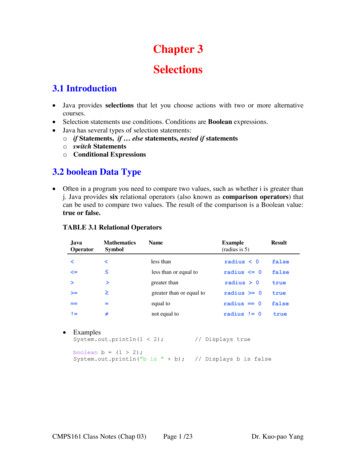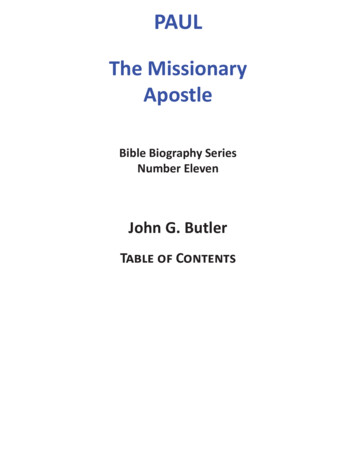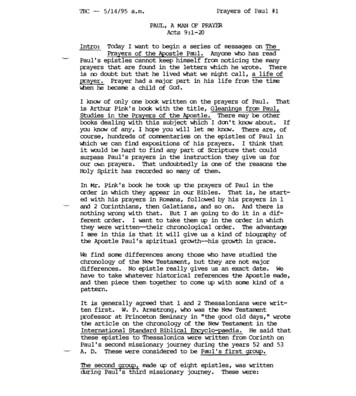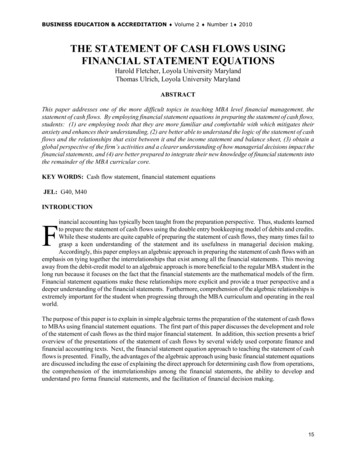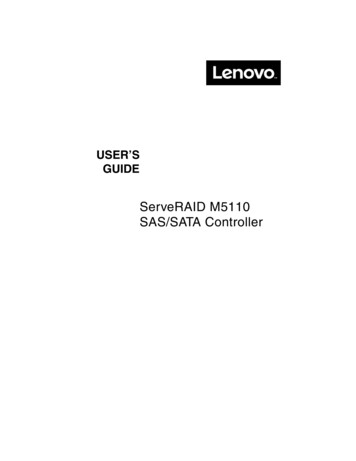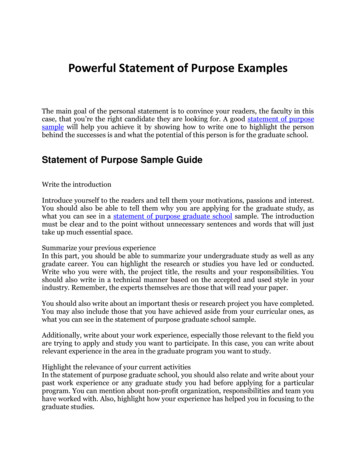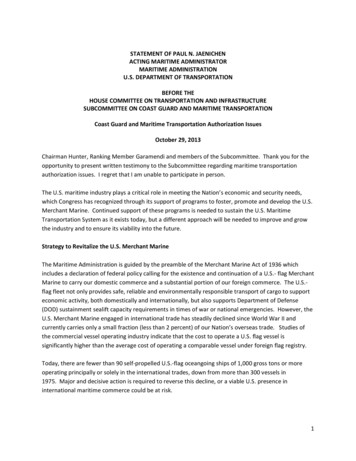
Transcription
STATEMENT OF PAUL N. JAENICHENACTING MARITIME ADMINISTRATORMARITIME ADMINISTRATIONU.S. DEPARTMENT OF TRANSPORTATIONBEFORE THEHOUSE COMMITTEE ON TRANSPORTATION AND INFRASTRUCTURESUBCOMMITTEE ON COAST GUARD AND MARITIME TRANSPORTATIONCoast Guard and Maritime Transportation Authorization IssuesOctober 29, 2013Chairman Hunter, Ranking Member Garamendi and members of the Subcommittee. Thank you for theopportunity to present written testimony to the Subcommittee regarding maritime transportationauthorization issues. I regret that I am unable to participate in person.The U.S. maritime industry plays a critical role in meeting the Nation’s economic and security needs,which Congress has recognized through its support of programs to foster, promote and develop the U.S.Merchant Marine. Continued support of these programs is needed to sustain the U.S. MaritimeTransportation System as it exists today, but a different approach will be needed to improve and growthe industry and to ensure its viability into the future.Strategy to Revitalize the U.S. Merchant MarineThe Maritime Administration is guided by the preamble of the Merchant Marine Act of 1936 whichincludes a declaration of federal policy calling for the existence and continuation of a U.S.- flag MerchantMarine to carry our domestic commerce and a substantial portion of our foreign commerce. The U.S.flag fleet not only provides safe, reliable and environmentally responsible transport of cargo to supporteconomic activity, both domestically and internationally, but also supports Department of Defense(DOD) sustainment sealift capacity requirements in times of war or national emergencies. However, theU.S. Merchant Marine engaged in international trade has steadily declined since World War II andcurrently carries only a small fraction (less than 2 percent) of our Nation’s overseas trade. Studies ofthe commercial vessel operating industry indicate that the cost to operate a U.S. flag vessel issignificantly higher than the average cost of operating a comparable vessel under foreign flag registry.Today, there are fewer than 90 self-propelled U.S.-flag oceangoing ships of 1,000 gross tons or moreoperating principally or solely in the international trades, down from more than 300 vessels in1975. Major and decisive action is required to reverse this decline, or a viable U.S. presence ininternational maritime commerce could be at risk.1
Accordingly, MARAD currently is developing a strategy to revitalize the U.S. merchant marine(Strategy). The Strategy will focus on incentives for ship owners to flag vessels under the U.S. flag withU.S. crews. Although the Strategy will likely include other segments of the industry, the initial focus willbe on developing options which, if implemented, could result in gains for the U.S. flag and potentiallyresult in a significantly higher portion of U.S. overseas trade for U.S. flag vessels. Increased U.S.overseas trade for U.S. flag vessels would also provide more jobs for American seafarers. In turn, thiswould increase the number of ships and mariners to respond in time of war or national emergencies.As a first step in developing a strategy to revitalize the U.S. merchant marine strategy, MARAD isorganizing a public meeting inviting the public and other Marine Transportation System stakeholders toparticipate in a discussion intended to develop such a strategy. The meeting is scheduled for January14-16, 2014 as published in the Federal Register on October 28th at Docket No. MARAD-2013-0101. Thegoal of the public meeting is to generate unconstrained ideas to improve, strengthen and sustain U.S.cargo opportunities and sealift capacity and to develop a list of items for action, voluntary adoption, orfurther study.Cargo PreferenceComplementing the approaches expected to be developed as part of the strategy to revitalize the U.S.merchant marine, MARAD has intensified its efforts to identify additional federal programs withinternational transportation opportunities. Engagement with Federal agencies that administerprograms that support international maritime trade has been expanded, and MARAD is workingexpeditiously on the rulemaking to modernize cargo preference rules consistent with Duncan HunterNational Defense Authorization Act of 2009.Maritime Security Program/ National Defense Reserve Fleet/Ready Reserve ForceIn accordance with federal policy, a priority of MARAD is ensuring the readiness and availability of acapable U.S. Merchant Marine fleet with modern U.S.-flag vessels, skilled labor and global logisticssupport to help meet national maritime transportation requirements in peacetime emergencies andarmed conflicts. The National Defense Reserve Fleet (NDRF) and its Ready Reserve Force (RRF)component provide valuable support to DOD in time of war or national emergency as one part of therequired sealift force.The Maritime Security Program (MSP) complements the RRF and the Military Sealift Command’s reservesealift vessels with operating assistance funds to a fleet of 60 privately-owned, militarily useful, U.S.flagged and U.S.-citizen-crewed ships. The MSP fleet ensures the U.S. military has assured access to aglobal fleet of ships in international commercial service, plus intermodal logistics capability, to movemilitary equipment and supplies when required. The MSP fleet helps support the employment ofapproximately 2,700 U.S. mariners and an additional 5,000 shore-side jobs—key personnel to providethe necessary base to support government vessel crewing. MSP vessels have been key contributors toour Nation’s efforts in Afghanistan and Iraq over the last decade, moving over 50 percent of all military2
cargo – over 26 million tons – to the Middle East. Since 2009, MSP carriers have moved over 90 percentof the ocean-borne cargo needed to support U.S. military operations and rebuilding programs in bothcountries.1 Of even greater significance, MSP carriers led development of multi-modal services intoAfghanistan via the Northern Distribution Network and establishing air-sea bridging that provide criticalalternative routes to resupply and support our U.S. military forces.Last year, Congress included language in the National Defense Authorization Act for Fiscal Year (FY) 2013to extend existing MSP contractor agreements through FY 2025. As of June 14, 2013, all 60 MSPoperating agreement holders extended their commitment to the program with U.S.-flag vessels andintermodal systems through FY 2025. The Continuing Appropriations Act, 2014 (P.L. 113-46), enactedOctober 17, 2013, provides full funding of 186 million for the program through January 15, 2014. Ithank the members of the Subcommittee for their support for this full funding. Given that MSPpayments only partially offset the cost to operating under U.S. flag, many of the vessel owners may shiftto foreign flag registry and continue operation without the MSP stipend. The loss of these vessels wouldmean the loss of experienced U.S. mariners with unlimited ocean credentials who can crew theGovernment-owned sealift fleet, and thus would diminish the country’s ability to meet critical nationalsecurity requirements with the assured access to this logistics capability. The Commander of the UnitedStates Transportation Command has reiterated to me and the Secretary of Transportation that a full 60ship MSP is needed to support DOD’s requirements. Continuation of full MSP funding for FY 2014 willensure support for DOD requirements under our own flag.Maritime EducationMARAD’s mariner training activities focus on preparing individuals for maritime careers whiledeveloping and maintaining a vital and viable U.S. Merchant Marine for commerce, emergencyresponse, and national security. The U.S. Merchant Marine Academy (USMMA) and State MaritimeAcademies educate and graduate Merchant Marine officers ready to serve the maritime industry andArmed Forces by providing the highest caliber academic study with state of the art learningfacilities. MARAD appreciates the Congressional support for the education and training of the Nation’sfuture Merchant Marine officers and maritime transportation professionals.As a result of the recent Federal government shutdown, MARAD will consider and may possiblyrecommend statutory authorizations that would minimize the impact of any future lapse inappropriations for the USMMA. While all the Federal service academies were forced to make changesas a result of the Government shutdown, the impact on the USMMA was especially severe becausenearly all of the USMMA’s faculty and staff are civilian federal employees. Unlike the other serviceacademies whose staffs include a large number of active duty military personnel, the USMMA1Report by NDTA Military Sealift Committee Maritime Policy Working Group, “The Use of Commercial Vessels andIntermodal Systems for Military Sealift,” 2009-2011 Addendum.3
experienced significantly reduced operations, classes were cancelled and administrative supportprograms ceased.The USMMA also operates under a very tight academic schedule, which makes it difficult forMidshipmen to make up for lost educational time. Specifically, the Midshipmen need to complete theircourse work and their sea days in order to qualify to take the U.S. Coast Guard licensing exam andgraduate. As a result of the shutdown, Midshipmen missed 13 days of class and will have to foregoscheduled academic breaks in order to complete their graduation requirements. Significant effort andcosts were expended to transport the Midshipmen back to the Academy when the Governmentreopened.Port Infrastructure and DevelopmentThe Nation’s ports are vital to the U.S. economy and ultimately job growth – our ports process 99.4percent of the nation’s overseas trade by volume and 65.5 percent by value2]. However, some of theport facilities we rely on as a Nation to move essential commodities are in a declining state of repair,and the current climate of eroding revenues and tight credit can stall infrastructure projects when andwhere they are needed most. Because much of this infrastructure is privately owned and operated, theFederal Government has historically taken a largely “hands off” stance regarding port development andexpansion. However, numerous ports have indicated a need for assistance in planning and State/localengagement to identify and secure the financing from all levels of government and from the privatesector to modernize and expand their infrastructure to meet current and future freight needs.Port infrastructure development legislation3 enacted in February 2010, directs the Secretary ofTransportation, through the Maritime Administrator, to “.establish a port infrastructure developmentprogram for the improvement of port facilities .”In response to the legislation, MARAD conducted extensive stakeholder engagement to identify the keyissues and solutions to develop the program’s framework and ultimately respond to the needs of theport community. Once fully implemented, the program – StrongPorts – will provide ports withsystematic support in three categories – Planning and Engagement, Financing and ProjectManagement. The program objective is to improve port capacity, efficiency and state of good repairthrough an improved planning process to attract private, local, state and Federal financing of“investment grade” projects. The first phase of the program began in late September 2013 with a jointventure between MARAD and the American Association of Port Authorities to develop a port planningand investment toolkit.2Source: “Port-Related Infrastructure Investments Can Reap Dividends,” by Kurt Nagle, President and CEO ofAAPA. Industry Today, Vol. 14, Issue 3.3Title 46, U.S. Code, Section 50302.4
Additionally, the President’s Budget Request for FY 2014 includes 2 million for the StrongPortsprogram, the majority of which will go toward port planning grants, if the funds are appropriated. Ourlong term vision is to assist hundreds of our Nation’s ports in improved planning, stakeholderengagement and infrastructure investment through this program to ensure they are ready for thesignificant growth in freight volumes predicted in the coming years.Marine EnvironmentAnother priority for the Agency is addressing the most pressing environmental issues facing themaritime industry. Of primary concern are invasive species in ballast water, energy/fuel consumptionand air emissions.Effective collaboration among government and industry stakeholders is necessary to effectivelytransition toward a “greener” maritime future. In the past two years, MARAD has been increasinglyproactive in analyzing and demonstrating alternative fuels/technologies for maritimeapplications. Some of these maritime applications place a strong emphasis on the use of naturalgas. MARAD’s Maritime Environment and Technology Assistance initiative will continue to advancecritical research on ballast water discharges, advance infrastructure and methodologies for certifyingand verifying ballast water technologies and improve vessel emissions data.Shipyards and Ship BuildingMARAD appreciates the Subcommittee’s continued support for programs to enhance domestic shipbuilding capabilities. Increased applications in FY 2013 for Maritime loan guarantees (Title XI) and SmallShipyard Grants reflect applicants’ willingness to invest in U.S. shipbuilding.For FY 2013, MARAD received 113 applications for 9.46 million in Small Shipyard Grant funding. Twelveshipyards in 10 states received grants. The current Title XI subsidy balance for pending and newapplications is 38 million, which will support approximately 421 million in shipyard projects assumingaverage risk category subsidy rates. MARAD is currently evaluating five applications requestingapproximately 1.026 billion in financing for 18 ships.Thank you for this opportunity to address maritime authorization issues. I appreciate theSubcommittee’s interest and look forward to working with members as we develop a strategy tostrengthen the U.S. Merchant Marine into the future.##5
SUBCOMMITTEE ON COAST GUARD AND MARITIME TRANSPORTATION Coast Guard and Maritime Transportation Authorization Issues October 29, 2013 Chairman Hunter, Ranking Member Garamendi and members of the Subcommittee. Thank you for the opportunity to present written testimony to the Subcommittee regarding maritime transportation authorization issues.
